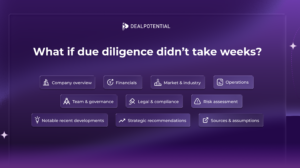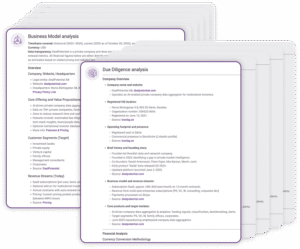
What if due diligence didn’t take weeks?
A leading US investment bank, focused on early- and growth-stage transactions, finally found a single tool to unify its fragmented deal intelligence.

With rising global instability, the rising demand for defense tech opportunities in 2025 is being driven by innovation in national security. The intersection of national security and technological innovation is fueling the rapid growth of dual-use technologies (NATO – Emerging and Disruptive Technologies), creating a wealth of opportunities in sectors ranging from AI and cybersecurity to biotech and space tech.
Here’s a breakdown of how the defense tech sector is evolving, and what it means for investors looking to capitalize on these opportunities.
Governments around the world are significantly increasing their spending on R&D to support national security needs (SIPRI Military Expenditure Database). The focus is on technologies with dual-use potential, such as:
This surge in government-backed R&D opens up substantial opportunities for private market investors to back innovative startups developing technologies that will serve both defense and civilian applications. Public-private partnerships are also becoming more common, offering a way for investors to secure returns while contributing to the advancement of national security tech.
The defense tech sector is heavily regulated, and the growing importance of dual-use technologies means stricter controls on export and use. This regulatory landscape can present both challenges and opportunities for investors:
For investors, understanding and navigating these regulatory hurdles will be critical. Firms with strong legal frameworks and experience working with government contracts will have an edge.
With critical infrastructure becoming a major target for cyberattacks, cybersecurity has become a key priority within the defense tech space. As nations enhance their digital security frameworks, the need for technologies that safeguard critical systems, protect data, and prevent espionage will continue to grow. Key investment areas include:
Investors focusing on companies that specialize in these technologies will be well-positioned to tap into the growing defense spending in the cybersecurity sector.
Geopolitical uncertainty has highlighted the fragility of global supply chains, leading to a push for localized production and increased resilience. In this context, defense tech plays a crucial role in ensuring the continuity of essential industries. Technologies such as:
are gaining traction. Investors should look for opportunities in companies that provide innovative solutions to strengthen supply chains for both military and civilian use.
Several emerging technologies are driving the future of defense, with applications that extend far beyond military needs. Notable sectors include:
As these sectors evolve, they present unique investment opportunities for private market investors who are prepared to support cutting-edge companies in their growth.
Dual-use technologies come with ethical dilemmas, particularly when it comes to surveillance, privacy, and military applications. As the defense tech sector grows, investors must take an active role in ensuring that their investments align with ethical standards and public expectations.
Transparency and responsible innovation will be key factors in maintaining public trust and mitigating potential backlash. Investors who prioritize companies with strong ESG frameworks will be better positioned to succeed in this space.
Defense tech investing is becoming a strategic priority for private equity and institutional investors in 2025. Driven by geopolitical instability, increasing government investments, and the rapid development of dual-use technologies. For private market investors, this presents an exciting opportunity to back companies that are not only at the forefront of technological innovation but are also shaping the future of national security.
By staying informed on regulatory changes, ethical considerations, and emerging trends in defense tech, investors can position themselves for long-term success in this evolving and high-stakes sector.
Book a free demo with DealPotential and get real-time insights on the next billion-dollar opportunities.
SHARE:

A leading US investment bank, focused on early- and growth-stage transactions, finally found a single tool to unify its fragmented deal intelligence.

Smarter valuations, sharper filters, and deeper insights, all live now.

Investment data intelligence drives smarter deal sourcing. Discover how DealPotential collects and trains private-market data.
We use cookies to improve your experience, analyze web traffic, deliver customized content, and support marketing efforts.
DealPotential Investment Intelligence Platform Proposal Agreement
WHEREAS, the Seller agrees to provide access to the DealPotential Investment Intelligence Platform,
WHEREAS, the Client agrees to purchase the DealPotential Investment Intelligence Platform according to the terms and conditions laid out in this contract.
THEREFORE, in consideration of the mutual agreement made by the parties hereto, the Seller and the Purchaser (individually, each a “Party” and collectively, the “Parties”) agree to the following:
2. Subscription: By subscribing to the Platform, you agree to pay the monthly or yearly subscription fee, as specified in your subscription plan.
3. Payment: Payment is due monthly in advance and processed via Stripe. The subscription renews automatically until cancelled.
4. Cancellation: You may cancel your subscription at any time, and it will take effect at the end of the current billing cycle. No refunds will be provided for partial months.
5. Data Privacy: We are committed to safeguarding your data. Please refer to our Privacy Policy for details on data handling and protection.
6. Intellectual Property: All content, data, and reports provided by the Platform are protected by intellectual property laws and are for your internal use only.
7. Termination: We reserve the right to terminate your access to the Platform for any violation of these terms or for any reason at our discretion.
8. Governing Law: These terms are governed by the laws of Sweden, and any disputes shall be subject to the exclusive jurisdiction of the courts in Sweden.
10. Disclaimer: We disclaim all responsibility for any decisions made by users based on the data provided in our platform. All investment decisions are solely the responsibility of the user. We are not involved in any user decisions and only provide data and assessments for informational purposes.